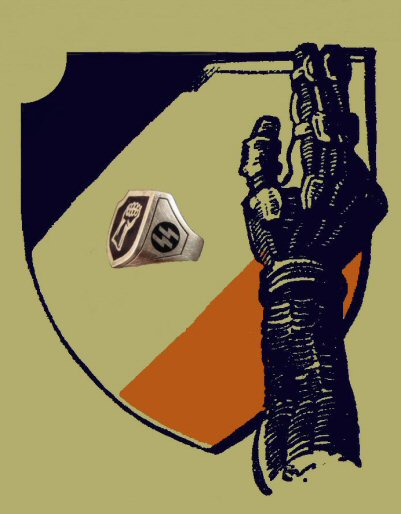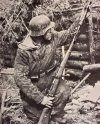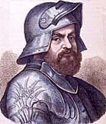Ring of the Götz von Berlichingen Waffen-SS, 17th Panzergranadier Division
|
|||||||||||||||||||||||
|
Ring of the Götz von Berlichingen Waffen-SS, 17th Panzergranadier Division (Item WAF 6-12) |
|||||||||||||||||||||||
| DESCRIPTION: The original Götz was a German knight, soldier of fortune, and sometime-robber baron. He was born around 1480 to a noble family at the Schloss Jagsthausen in Württemberg. He owned several other castles including the Schloss Hornburg located near the Necker River. Berlichingen was made famous by writer and poet Johann Wolfgang von Goethe, 1749-1832, who wrote a play based on his life. He first entered the service of Frederick I Margrave of Brandenburg Ansbach in 1498. He fought in the armies of holy Roman emperor Maximilian I seeing action in Burgundy, Lorraine, and in the Swabian, but by 1500, Berlichingen had left the service of Frederick and formed a company of mercenaries, hiring his services for various dukes, margraves, and barons for a fee. In 1508 he and his company fought for Albert IV, Duke of Bavaria. During the siege of the city of Lanshut, he lost his right arm to enemy cannon fire. He then had a prosthetic iron replacement made, which is still on display at the Schloss Jagsthausen. In spite of this Berlichingen continued his private wars; the main motive being money. Most of his battles were raids on the rich towns or merchant caravans and the occasional kidnapping for ransom of minor nobles. For all of this he was placed under an imperial ban and was only released from this by Emperor Maximilian when he paid 14,000 gulden. In 1516, Berlichingen and his company mounted a raid into Hesse capturing Philip IV, Count of Waldeck. For information on the Waldecks, see Item SS 25-1. A ransom of 8,400 gulden was paid for the safe return of the count. For this action he was again placed under the ban. In 1518, after this, there were countless battles after battles, wars after wars that this old warrior led troops in including his brilliant service (without pay) against the Ottoman Empire of Suleiman the Magnificent, in Hungary. This was service to Charles V, Holy Roman Emperor, and in 1544 he was at the forefront of battle in the imperial invasion of France under Francis of France. He then finally returned to the Hornburg and lived out his days in relative peace. He died on 23 July 1562 in the castle at Horneck. Under the second ban, the bishop of Bamburg sent an emissary to Berlichingen’s castle and demanded his surrender and then came his famous reply: “Er kann mich im Arsche lecken!,” “He can kiss my ass.” This phrase went down in history, and today if you want to insult someone in Germany you do not sound out this phrase, but just say:“ Götz von Berlichingen.” That message is clear. The 17th SS Panzer Granadier Division was raised near Poitiers, France in October 1943. It was formed from scratch with the majority of its original cadre coming form replacement units and conscripts; many of Romanian extraction. The division was granted the honor title Götz von Berlichingen in honor and tradition of the toughest warrior knight of German history and they lived up to his fighting tradition in keeping with the saga of Götz and his prosthetic hand. The division’s emblem was the clenched iron fist. SS-Obersturmführer Otto Ringe oversaw the formation of the division with the newly appointed SS-Brigadeführer Werner Ostendorf taking command in January 1944. The division was placed under L XXX army corps, a part of the Generalfeldmarschall Gerd von Rundstedt’s Heersgruppe D. All of their fighting was against Americans in several engagements after the D-day invasion. This information can be found in lengthy reports by going into Google for a search. Regrettably they were accused of killing American wounded, but this was merely an accusation never proved; nor was anyone indicted or tried; however, it is certain that some of the troops of Götz von Berschlingen became victims of war crimes by the Americans. In 1976, the remains of about 200 men from the 1 Battalion 38 SS Regiment were found and positively identified and apparently murdered by troops from the U.S. 42nd Infantry Division and buried in a mass grave near Nuremberg. Most had been shot at very close range supporting the fact that a massacre had taken place. The division served honorably as German soldiers fighting for their fatherland and for Europe. The rings produced for this division are possibly all that exist to memorialize these young Spartans. The ring is massive and the original old warrior knight Götz would surely approve. It bears the shield that is exactly like the armored vehicle marking of the unit. The roundels on the side have the SS runes on one side and the swastika on the other. It is certainly the greatest-looking ring of the Third Reich and its fighting forces. Their honor was loyalty!
PRICE: $950.00: Special reduction to $700.00. This is a significant reduction on a very historically important relic. |






















